Let's face it: Driving traffic to your website is a pain in the ass. You have a lot of competition to earn top spots in Google results.
This is where search engine optimization (SEO) plays a vital role. But unfortunately, many marketers are still following outdated SEO tips that focus too much on keywords and less on search intent.
And thanks to how search engine technology has advanced, search intent is where you need to put all of your focus when you're building your content strategy.
What Is Search Intent?
Search intent is what a user expects and wants to get out of a particular web search.
Focusing your content marketing strategy solely on keywords is a poor strategy. Google factors its users' search intent into every results page it serves up. It's time to adjust your strategy to include a user's intent.
All searches are associated with keywords, but the story doesn’t end there. Unless you come to grips with search intent, you can have a perfectly optimized page that still annoys the heck out of your audience – because it simply doesn’t lead them where they want to go.
Why Search Intent Matters
Simply put, search engines strive to best serve their users. So when people are inputting queries, search engines want to ensure they're delivering the right content to them.
If people aren't getting the results they want or need, they're going to get frustrated and keep scrolling through results to find the content that is relevant to their search.
There are many SEO benefits to using search intent to inform how you create content and target your ideal audience.
You Can Reduce Bounce Rates.
What's the first thing you do when you land on a webpage and realize that the content will not help you? You likely reach for the back button on your browser.
Your visitors are doing the same when you fail to serve them content that is relevant to their needs, which can really hurt your bounce rate, which is the percentage of visitors who enter and leave your site instead of navigating to other pages on your site.
You Can Expand Your Audience Reach.
There are many different variations to how searchers are looking for information. Many queries will be related.
For example, you can use queries like SEO tips, tips for SEO, SEO best practices, and best SEO strategies. All of these are similar in that they relate to SEO tips. The queries are different, but the results will be similar.
So by creating content with a broad topic in mind, you're optimizing for and potentially ranking for several related queries. You should strive for relevance to show up in a variety of queries.
You Can Earn More Pageviews.
If you're among the top ranking results for a user and they consistently find you high in SERPs, they're going to start trusting you as a credible resource. In turn, they're likely going to keep going to your site for the insights they need.
They will explore more within your website and consume more of your content, which boosts your pageviews. This can help build trust with visitors, convert them to leads, and potentially close them as customers.
You Can Rank in Position Zero.
Ranking in the number one spot is amazing, but hitting position zero is even better. The term "rank zero" refers to the results found on SERPs above the fold, above all organic search results, and below paid advertisements.
Rank zero comes in the form of featured snippets. The most common types of featured snippets include:
Paragraph Type
These are the most common snippets you'll see. They are delivered in the form of a written paragraph (duh), directly answering a specific query. Queries that use "how to...," "who...," "why...," and "what..." often yield paragraph type snippets.
Additionally, the snippet box will feature an image to complement the content within the paragraph.
For example, when you search, "what is the inbound methodology?" in Google, this is what you see.
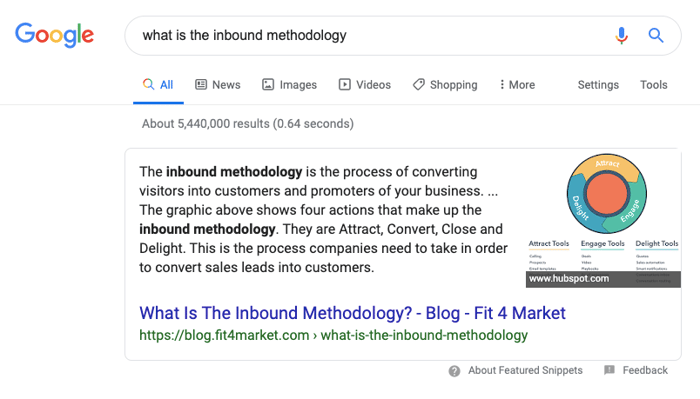
As you can see, the top result concisely defines it, and the snippet image shows the flywheel framework associated with the inbound methodology.
Numbered List
These kinds of snippets are displayed when search engines identify a searcher's intent that is associated with a list of steps needed to complete a specific task.
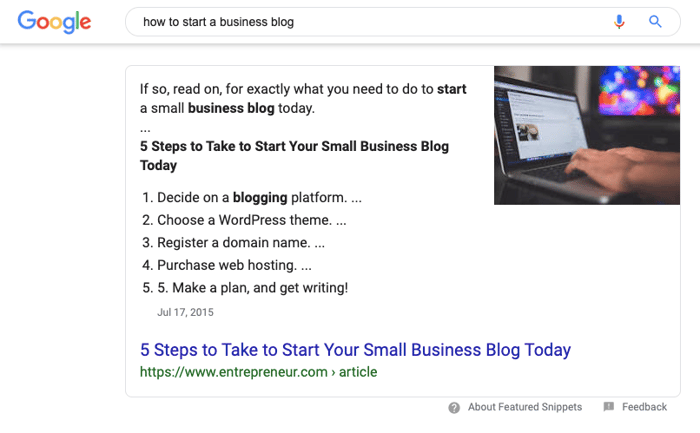
In this example, when you search for how to start a business blog, Google presents you with a list of five simple steps to follow. Again, this matches your intent – you're merely looking for a step-by-step guide to take action on starting your first business blog.
Bulleted List
Everyone knows how prevalent listicles are on the internet. They're everywhere because they're great for presenting complex information into digestible listed items.
Google will format a bulleted list snippet by including the heading of the list post, along with the listed items in a compressed view.
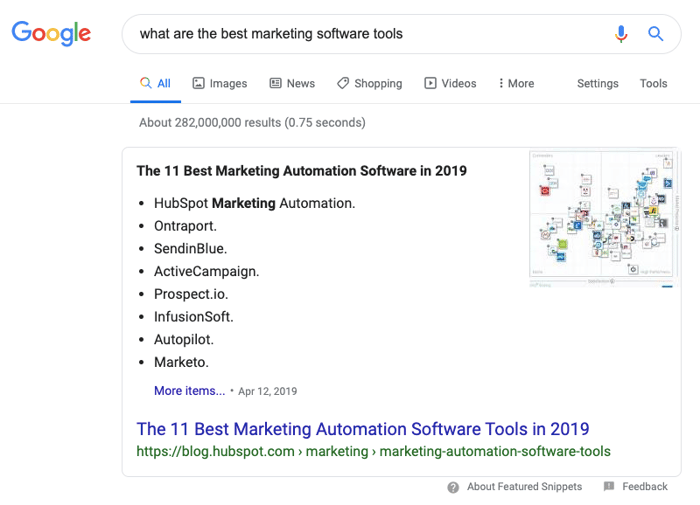
For this example, when you search for the best marketing software tools, Google displays the bulleted list in a HubSpot blog post. This makes it easy for you to skim the listings and get the information you need in no time.
Table
These kinds of snippets are perfect when search intent aligns with content that includes comparison charts based around numerical data. Google will reformat the data in high value content and present it in a table for simplified readability.
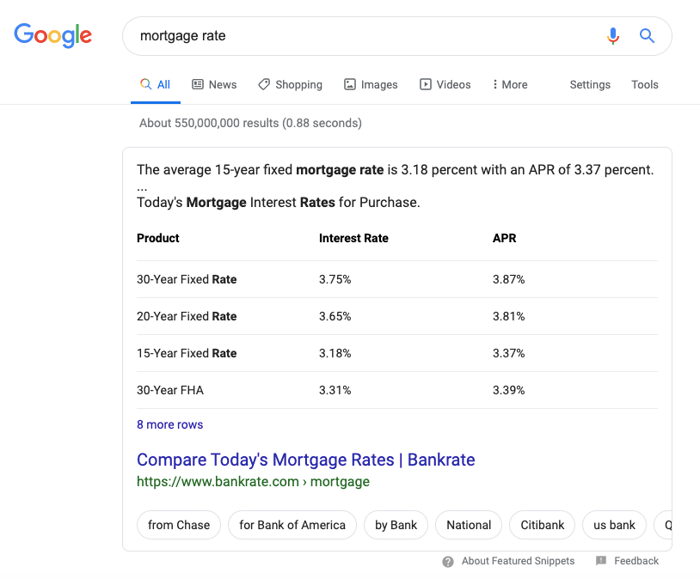
In this example, Google pulls data from the Bankrate post and displays in a simple table to give the searcher a visual breakdown of products and their associated interest rates and APR.
Types of Search Intent
There are four main motivations that drive people to search:
Informational Searches
People are looking to get background information, answer a question, or solve a specific problem. They might use question words such as “how” and “why” to get their point across.
As they gather info, they’re more likely to phrase searches in the form of a natural language question.
Navigational Searches
These are searches where people are looking for a specific website. Many brand name searches fall into this category.
When the navigation or search function of a given website sucks, you’ll often find users typing things like “pay credit card bill online” directly into Google to find the right page.
Transactional Searches
These searches usually mean that people are in the last stages of consideration and ready to make a choice – or they’ve already made the choice and they want to execute on it.
Specific brand names and product types make a search more likely to be transactional.
Commercial Searches
This kind of search often takes place before the user is ready to buy. They're looking for a specific product or service, but they haven't narrowed down their search to a final decision.
In other words, they're still weighing options, so search queries might include words like "___reviews," "___ vs. ___," or "best ___."
An Example of Search Intent Gone Wrong
Let’s look at what’s probably the most egregious and widespread case today: “Near me.”
Searches that end with "near me" have become ubiquitous in the era of mobile. Their intent is simple: A person using a mobile device wants options, including directions or reviews, for every example of a certain type of business that’s – wait for it – near them.
Because the sheer volume of these searches exploded overnight, lots of companies decided this was SEO real estate they needed to stake out to stay competitive. That resulted in a lot of blogs and other random content pages with awkward formations like this:
- “If you’re wondering about the best dentist near me ...”
- “Don’t search for steakhouses near me, come to ...”
- “The best chiropractor near me is a common question ...”
This is a classic case of ignoring search intent in favor of any old traffic. It discards the meaning behind the search.
In this case, it captures people who might be interested in your service but probably aren’t in a position to visit you. In short, this is non-converting traffic.
This particular example is so bad, even people who don’t know anything at all about SEO or digital marketing will notice it. And if your website simply sounds weird because of something you’ve done for marketing purposes, you’re headed in the wrong direction!
Google has done a terrific job of actually honing in on its users' intent and now serving up relevant results... not based on keywords.
Remember: Search Terms Get More Specific Over Time
The big problem: Many search terms are ambiguous on their own.
Without context, it’s often easy to mistake one search intent for another.
Luckily, search intent becomes clearer over time as the user gathers facts and establishes buying criteria.
Let’s take an example based on how it works in the real world:
- "Things to do in Amsterdam" – the user is planning a trip and wants to know about the city.
- "Amsterdam weather in June" – the user needs input to decide how to spend their time.
- "Amsterdam walking tours" – the user wants to explore all the options for a walking tour.
- "Best Amsterdam walking tour" – the user wants to compare options for the “best” tour.
- "Oranje Umbrella walking tours" – the user has picked a vendor and wants to see their site.
- "book Oranje Umbrella walking tour Amsterdam" – the user is ready to book the tour.
That’s six different searches – and the search intent evolves every time.
Even though a person could absorb all that information is as little as half an hour, he or she still absorbs a tremendous amount of context about a trip to Amsterdam. Each answer influences future buying decisions.
How to Optimize Your Content for Search Intent
There are a few simple steps you need to follow to create content that actually aligns with what the user is intending to look for.
1. Check the Reliability of Ranking Potential.
SERPs are never the same. As more content is published and as search engine technology evolves to deliver more relevant results, rankings will always shift.
So when you're looking to rank for specific areas of search intent, look at the ranking history of certain keywords. You can use tools like Ahrefs to identify what topics are worth targeting and which ones are too volatile to attempt to rank for.
Ranking history that shows a lot of fluctuations in rankings indicates that the search intent is always changing and that Google is not fully understanding the actual intent behind that specific search.
In short, pursue keywords that have consistent ranking history.
2. Align Content With Format, Type, and Angle.
After choosing keywords that have clear intent, you need to sift through the highest ranking content to identify what Google is serving to users. Look at what type of content is high in the rankings, as well as what the format is and what angle the content is taking on the subject.
The content type is usually blog posts, product pages, landing pages, and category pages. When it comes to format, identify what the top ranking pages have in common.
Are they step-by-step tutorials or list posts? How to guides? Reviews? There are many different formats, so pay attention to these to tailor your approach.
Angle matters because it sheds light on how content is approaching the topic. This should inform how you write about that topic. So if top ranked content for the keyword "marketing automation software" is focusing on comparing prices, for instance, then you want to include a side-by-side comparison of prices and features in your post.
3. Research Top Ranking Pages.
At this point, you have a good understanding of the searcher's intent and what the high ranking content looks like. But you should dive a little deeper for a more comprehensive picture of what your content should look like.
Take a look at the top ranked pages to identify characteristics that they share. For example, the top few rankings might have a lot of images and video, or they might include clear calls to action (CTA) for visitors who are ready to purchase.
You can also look at the "people also ask" box on SERPs to see other questions related to the keyword. You can answer these other questions directly in your content.
Create Content Aligned With Search Intent
Search intent corresponds closely with the steps of the buyer's journey.
Although it’s easiest to see this in B2C, the same principle is in action for B2B buyers.
The challenge for businesses and digital marketers: Pay close attention to the clues users offer you and provide them with the content they really want.
Ensure that simpler (and vaguer) queries lead to general content that moves the user seamlessly toward more specific pieces as needed.
And, no matter how tempting it is, never ignore user intent to twist a keyword’s meaning. You might raise your search visibility for a while, but most of the traffic you get will go straight to your bounce rate. That means aggravated users and an undermined content strategy.

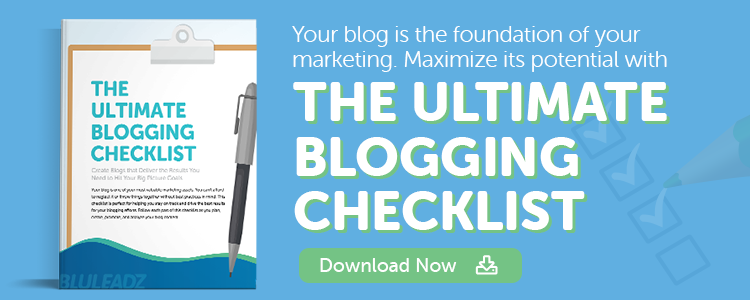
Jeff Previte
I am a Content Manager at Bluleadz. I enjoy spending time outdoors -- camping, hiking, hammocking, and everything in between. I also love reading, writing, and learning how to play guitar.